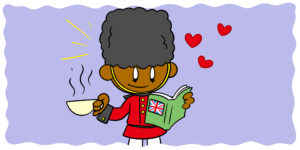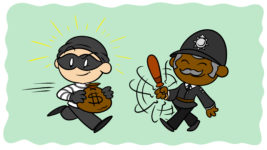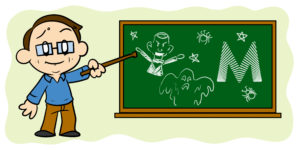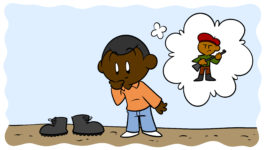This is a two-part article. For part 1, click here.
In part 1 of this guide to inventing a fictional language, I described the tips and tricks you can use to construct your vocabulary and grammar. But as I said then, we’re not done yet – real languages aren’t perfect systems, and their intricacies and peculiarities bear the marks of history.
Even then, a perfectly designed language isn’t enough; your reader still needs it to be presented in a way that engages them. That’s what we’ll be covering this time, beginning with how idiosyncrasies in language breed realism.
Influential events
Who’s the worst person who ever lived? Personal answers may vary a little, but as a culture, we’ve codified ‘Hitler’ as more than a name. It’s a byword for a terrible, controlling person, and a frequently hyperbolic insult when applied to others.
Obviously, this usage emerges from historical events, but it also fills a niche in our language – it’s natural for a society to formalize their ‘worst person ever’. That being the case, who was ‘Hitler’ before Hitler?
There are a few answers, most of them biblical, but the front-runner seems to be the Pharaoh from the story of Moses. It isn’t surprising that there has always been a ‘worst person’, but reading accounts of ‘Pharaoh’ usage shows that it was even used in a similar way.
No man was a warmer wisher for reconciliation than myself, before the fatal nineteenth of April 1775, but the moment the event of that day was made known, I rejected the hardened, sullen-tempered Pharaoh of England forever…
– Common Sense, Thomas Paine
Once you have the structure of your language, it’s time to start considering major events that would lead to unique terms and phrases. An easy method of approach is to reflect on the phrases we currently find useful – figures, locations, and events from history that would fulfill expressions any realistic civilization could be expected to have. What’s a terrible prison for when villains are thrown into their own version of the ‘Black Hole of Calcutta’? Where’s the back end of nowhere, who’s particularly virtuous or famously intelligent?
Consider methods of communication as you develop these idiosyncrasies – if your fictional culture is primitive, there are only going to be a few references that everyone shares, and they’ll likely come from huge historical events or shared mythology. If your culture is more developed, take art and changing history into account. There are no Lotharios or Casanovas in your world, because there was no Don Quixote or Histoire de ma vie to fix them in the language.
Work out your version of the expressions any society needs.Click To TweetThis may seem similar to slang and idioms, which I talked about in part 1, and the reasoning is the same, but these idiosyncrasies are a vital part of the larger inventive process. We’ve established the broad structure of your new language, and in finding idiosyncrasies, we’ve given it definition and context in the modern day of your story. Now, for your language to feel genuinely realistic, we have to consider how it got there.
The past is a foreign country
In the real world, languages change over time – even in the modern age, they aren’t static, and there’s no ‘true form’ of a given language, just its most modern and popularly accepted incarnation. Languages weave and interweave, swapping words and even conventions, and terms frequently metamorphose simply through use. We have ‘goodbye’ because enough people saw utility in a shorter form of ‘God be with you’, and whenever an entrepreneur makes the faux pas of eating a croissant at a café, they do it using words that originated in France.
The history of your language is the story of how it came to take its present form, and while this type of deep world building can be difficult, it’s what gives your language the kind of structure that grabs fans for a lifetime.
J.R.R. Tolkien famously made a hobby of creating his fictional Elvish language, complete with their history. In Tolkien’s histories, the elves speak a variety of languages derived from the same ancient tongue. John McWhorter’s TED-Ed video essay ‘Are Elvish, Klingon, Dothraki and Na’vi real languages?’ points out that the First Elves used the word ‘kwendi’ to mean people, but as they spread and separated into groups, this became ‘pendi’ for the Teleri and ‘kindi’ for the Avari.
Each word varies from the original form in a different way, creating apparently different terms that nevertheless have an organic relationship. You can use this method forwards or backwards – beginning with the word you want to use and working out how it came to be or beginning with basic forms and logically extending them. Remember that many words come from similar roots, so if you think up a word for ‘warrior’ that you really like, consider how you can pick it apart to find similar words for ‘war’, and vice versa.
Once you have some key terms, reverse-engineer where they came from.Click To TweetLanguage is full of relationships and diversions like this, but McWhorter also points out the value of exceptions.
Real languages are messy! That’s because they change, and change has a way of working against order… Real languages are never perfectly logical. That’s why Tolkien made sure that Elvish had plenty of exceptions; lots of verbs are conjugation in ways you just have to know. Take even the word ‘know’. In the past, it’s ‘knew’, which isn’t explained by any of the rules in English. Oh well. In Elvish, ‘know’ is ‘ista’, but ‘knew’ is ‘sinte’. Oh well.
– John McWhorter, ‘Are Elvish, Klingon, Dothraki and Na’vi real languages?’
Note that even Tolkien chooses an exception that already exists – there’s nothing wrong with structuring your new language around existing trends (in fact, it’s probably going to be essential).
In creating a fictional language, this type of natural evolution is a dense, difficult job, but that’s why we have our influential events. If language naturally shifts and changes, massive historical events are rocks hurled into the pond – they make a splash and shake things up. Use these moments of historical upheaval as waypoints in the journey of your language. A major war, plague, famine, or cultural exchange can be used to fudge the details a bit.
Started diversifying your language but not sure how to make the leap forward into different dialects and variants? Throw a war at your fictional civilization and it makes sense for their language to change quickly as they interact long-term with a different language and split into the kinds of groups that encourage rapid iterations of slang and specialist terminology.
Equally, don’t underestimate the power of education and the formalization of language. A great many of the different conventions in English and American English are the work of one man – Noah Webster – who produced what became the standard textbook for teaching American English, making what he felt were sensible changes to the languages, generally along the lines of spelling words more phonetically. ‘Centre’ became ‘center’, ‘axe’ became ‘ax’, ‘colour’ became ‘color’, and ‘tongue’ became ‘tung’ (they didn’t all stick).
Again, introducing an event like this is an easy way to organize and codify your fictional language. Even if the natural progression isn’t quite leading where you want it to, a well-placed academic can give you an excuse to bend vocabulary and grammar to your writing.
How much of your fictional civilization can read and write? If they can’t or don’t, language may be a lot more fluid (though it should still emerge from consistent rules). There are famously six surviving signatures believed to be written by William Shakespeare – none of which are the same, and none of which are spelled ‘William Shakespeare’.
Happily, real language accounts for a lot of mess and aesthetic inconsistency, so as long as you lay a solid foundation, a high degree of messiness is acceptable. Remember, however, that language exists and persists for a reason – in his time, it clearly wasn’t necessary for Shakespeare to spell his name the same way each time he wrote it, but it was still understood as the same name, and it still emerged from a consistent structure of language. He never signed anything ‘Xhkfk’, after all.
Teaching your language to the reader
At this point, you’ve got a language that has a consistent structure and enough bumps and bruises to pass for a realistic history. Now, it’s time to teach it to the reader.
First of all, be very careful how you go about this. As I detailed in One Simple Rule To Avoid Technical Details Ruining Your Story, it’s really easy to hurt your book by piling on information the reader has no reason to care about.
The first tip, then, is to give them a reason to care. Attach your language to moments and people of import. If your language appears in full when the protagonist is just trying to buy a pair of shoes, it acts as an inconvenience to the reader – it’s not so much that they want to know what was said, just that they’re annoyed at being closed out.
On the other hand, if your language is spoken by a charismatic character or in a situation of import, it suddenly offers the reader an understanding they want. Lewis Carroll’s ‘The Hunting of the Snark’ relies on this impulse – its slew of nonsensical poetry is built around the core purpose of hunting the titular creature. For as much as the reader doesn’t quite understand, Carroll makes it clear that the protagonists’ quest is one fraught with danger. What exactly is a ‘Snark’, and what does that mean for the characters? Carroll makes it matter, prompting the reader to pick over his invented words for hints of meaning.
Don’t assume the reader automatically cares about your language – give them a reason.Click To TweetSimilarly, don’t pile too much on your reader at once. If possible, let them puzzle over a single word before letting them in on its meaning. As I said in part 1, this can often be done with context, putting the reader in a position where they can figure out a word and enjoy the sense of pride and ownership that follows. A good method is to insult the protagonist in your new language; this gives the protagonist and the reader a reason to want to know the true meaning of the word, and offers you an opportunity to do some subtle world building – after all, what this new language codifies as an insult tells us a lot about their priorities.
This isn’t the only way you can use characters to teach the reader. Often, the best way to get a reader interested in an invented language is to give them a representative in the story. If a character doesn’t know what people are saying – but would like to – they can ask all the questions, and receive all the explanations, that the reader needs to catch up. Again, though, remember not to pile too much on – keep things interesting. Puzzles and riddles are a good way of doing this – in The Fellowship of the Ring, the Doors of Durin bear an inscription initially mistranslated as ‘speak, friend, and enter’. A better translation would be ‘speak ‘friend’ and enter’, and the Elvish word ‘mellon’, meaning ‘friend’, is the password that opens the door. It’s a relatively small moment, but it renders Tolkien’s invented language intriguing and makes the translation an impressive feat – exactly how you get the reader excited to learn more.
These primary stages are a good way to use story to grab the reader’s interest and get them invested in exploring your language. That might be enough for you, especially if you’re writing a series, or you may have an organic way to weave your language into your story, but many writers opt for other ways to educate the reader further.
A Clockwork Orange includes a glossary of Nadsat terms for the reader, while 1984 includes an appendix that doesn’t just list Newspeak words but also explains many of the principles behind the language. Tolkien’s appendices are the stuff of legend, sharing vast amounts of detail about his world and all its component parts, but all these measures only work if you’ve got the reader’s interest. It’s an odd reader who sits down and memorizes every Nadsat term before they encounter it in the novel – that comes later, either when they encounter a term in the story or when they’ve finished it and want to explore the world further.
Making things clear
Inventing a language is a lot of work, but it’s also an exercise in degrees. You’re always faking language, but you can do it simply, by inventing slang, or the hard way, by imagining a whole history and how it might shape the spoken and written word.
Whichever way you want to go, remember to keep your fictional culture at the center of your language. What do they value? What do they most want to express to each other? These are the guiding lights of your language.
Ultimately, language is a strange beast, and its idiosyncrasies are as vital as its structure. If you’re inventing a language, you’re probably also doing your fair share of world building, so be sure to allow one to influence the other. A lot of strange, tragic, funny things have come about because of language, just as a lot of events have shaped language in strange, tragic, funny ways. Real events are often so random that they can’t work in fiction, but it always helps to keep in mind how genuinely strange language can be.
A realistic language needs to be messy but consistent: the exception proves the rule.Click To TweetThis is something Douglas Adams frequently uses to comic effect in his writing, but even pushed to its extremes, there’s an underlying truth to the miraculous ways language can surprise you – plenty of momentous historical events have unfolded from mistranslations and misunderstandings.
For instance, at the very moment that Arthur said “I seem to be having tremendous difficulty with my lifestyle,” a freak wormhole opened up in the fabric of the space-time continuum and carried his words far, far back in time across almost infinite reaches of space to a distant galaxy, where strange and warlike beings were poised on the brink of frightful interstellar battle.
The two opposing leaders were meeting for the last time.
A dreadful silence fell across the conference table as the commander of the Vl’hurgs, resplendent in his black-jewelled battle shorts, gazed levelly at the G’Gugvuntt leader squatting opposite him in a cloud of green, sweet-smelling steam, and, with a million sleek and horribly beweaponed star cruisers poised to unleash electric death at his single word of command, challenged the vile creature to take back what it had said about his mother.
The creature stirred in his sickly, broiling vapor, and at that very moment the words ‘I seem to be having tremendous difficulty with my lifestyle’ drifted across the conference table.
Unfortunately, in the Vl’hurg tongue this was the most dreadful insult imaginable, and there was nothing for it but to wage terrible war for centuries.
– Douglas Adams, The Hitchhiker’s Guide to the Galaxy
Finally, once you have your language, find a way to make it valuable. Make it a puzzle for the reader, and be clear on what their reward is for working to understand – do they get a secret, a deeper understanding of a character, or the resolution to a moment that seems important? Make the reader want to understand – and make them feel smart when they do – and you can obsess people in a way few other literary devices can manage.
Now that you’ve read both parts of this article, do you have any questions about writing your own language? Which part seems most daunting, and what can you share about your own experiences to help other authors find their path? Let me know in the comments. Or, for more great advice that can inform your language, check out You’re Making A Mistake In Your World Building: Here’s How To Fix It and Are You Writing Believable Non-Human Characters?






2 thoughts on “Want To Invent A Fictional Language? Here’s How To Do It – Part 2”
Hi, thanks so much for posting this.
I’m trying to make a conlang for my fictional world but I’m struggling to figure out how to incorporate it into my story. Do I start of with small words then gradually use sentences? And what if my protagonist it’s completely clueless to the language and there’re no translators? How should I write that?
Thanks again for this guide, covering things I never considered before.
Hi Nathan,
Thanks for commenting. The best method is to have the reader encounter the language via a character, allowing their reactions to mirror the reader’s and thus make them more comfortable. In terms of introducing the language, remember that you’re the author, and you can rearrange the world to suit your purposes. Could you include a translator character who gives the protagonist the basics and then dies off, leaving them with an incomplete understanding, but enough to keep the reader’s interest?
Best,
Rob